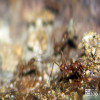Atta cephalotes
Leaf-cutter ants are approximately 1/2-inch long. They can be distinguished by a variety of features: shiner tough outer protective layer (integument) caused by the lack of hexagonal micro sculpture, and the lack of small teeth or dents on the head anterior to the posterolateral spines.
Colonies of up to several million ants are found, each established by a single female queen. Each ant in the colony has a designated role. The ants live about 10 to 20 feet below ground in large cavities and tunnels, which they create themselves by carrying the dirt back to the surface. They moisten the walls with saliva to harden them against cave-ins.
Leaf-cutter ants are a unique species of ant. They are unable to directly digest the leaves that they cut, so they have evolved into remarkable fungus farmers. This fungus is found nowhere else in the world, and the fungus is the only food the ants can digest. In order for this fungus to decompose leaves, it needs enzymes from fecal secretions of the worker ants. It is a true mutual symbiosis, since the ants and fungus depend solely on each other to survive.

